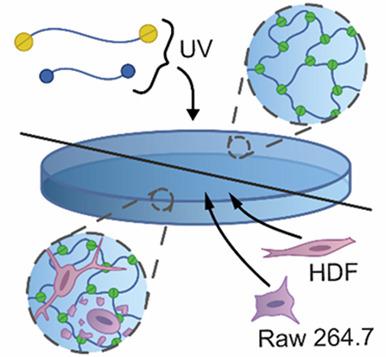当前位置:
X-MOL 学术
›
J. Polym. Sci.
›
论文详情
Our official English website, www.x-mol.net, welcomes your feedback! (Note: you will need to create a separate account there.)
Modular, synthetic, thiol‐ene mediated hydrogel networks as potential scaffolds for 3D cell cultures and tissue regeneration
Journal of Polymer Science ( IF 3.4 ) Pub Date : 2020-09-09 , DOI: 10.1002/pol.20200530 Mads Lüchow 1 , Lisa Fortuin 1 , Michael Malkoch 1
Journal of Polymer Science ( IF 3.4 ) Pub Date : 2020-09-09 , DOI: 10.1002/pol.20200530 Mads Lüchow 1 , Lisa Fortuin 1 , Michael Malkoch 1
Affiliation

|
Natural polymers such as collagen are popular materials for tissue engineering scaffolds due to their innate bioactivity and biocompatibility. Being derived from animal sources, however, means that batch‐to‐batch consistency is often low and the extraction of collagen is costly. This conundrum facilitates the need for synthetic alternatives as scaffolding materials. In this study, a system of poly(ethylene glycol) (PEG)‐based thiol‐ene coupled (TEC) hydrogel scaffolds is presented for tissue engineering purposes. The platform includes several necessary features, namely cytocompatibility, high swelling ability, biodegradability, tunable stiffness, and fast, straightforward fabrication. The swelling ability is provided by the hydrophilicity of the ether‐links of PEG, which facilitated the formation of high water content hydrogels that match the water content of soft tissues for the proper diffusion of nutrients and waste compounds. TEC ensures fast and facile fabrication, with cross‐linking moieties that allow for the biodegradation of the hydrogel network through hydrolytic cleavage. The mechanical properties of the scaffolds are made tunable in the range of storage moduli spanning <1 kPa to >100 kPa. It is also shown that despite the synthetic nature of the hydrogels, human dermal fibroblasts and murine macrophages, Raw 264.7, were able to survive and produce extracellular protein excretions while embedded in the 3D hydrogels.
中文翻译:

模块化,合成,硫醇烯介导的水凝胶网络可作为3D细胞培养和组织再生的潜在支架
天然聚合物(例如胶原蛋白)由于其固有的生物活性和生物相容性,是组织工程支架的常用材料。但是,由于来源于动物,这意味着批次间的一致性通常很低,并且胶原蛋白的提取成本很高。这个难题促进了对合成替代品作为脚手架材料的需求。在这项研究中,提出了一种用于组织工程目的的基于聚乙二醇(PEG)的硫醇-烯偶联(TEC)水凝胶支架的系统。该平台包括几个必要的功能,即细胞相容性,高溶胀能力,可生物降解性,可调节的刚度以及快速直接的制造方法。PEG醚键的亲水性提供了溶胀能力,它有助于形成高含水量的水凝胶,使其与软组织的含水量相匹配,以使营养物质和废物化合物正确扩散。TEC通过交联部分确保快速,简便的制造,该交联部分允许通过水解裂解对水凝胶网络进行生物降解。使支架的机械性能在<1 kPa至> 100 kPa的储能模量范围内可调。还显示,尽管水凝胶具有合成特性,但人类皮肤成纤维细胞和鼠巨噬细胞Raw 264.7在嵌入3D水凝胶时仍能够生存并产生细胞外蛋白排泄物。具有交联部分,可通过水解裂解实现水凝胶网络的生物降解。使支架的机械性能在<1 kPa至> 100 kPa的储能模量范围内可调。还显示,尽管水凝胶具有合成特性,但人类皮肤成纤维细胞和鼠巨噬细胞Raw 264.7在嵌入3D水凝胶时仍能够生存并产生细胞外蛋白排泄物。具有交联部分,可通过水解裂解实现水凝胶网络的生物降解。使支架的机械性能在<1 kPa至> 100 kPa的储能模量范围内可调。还显示,尽管水凝胶具有合成特性,但人类皮肤成纤维细胞和鼠巨噬细胞Raw 264.7在嵌入3D水凝胶后仍能够生存并产生细胞外蛋白排泄物。
更新日期:2020-11-17
中文翻译:

模块化,合成,硫醇烯介导的水凝胶网络可作为3D细胞培养和组织再生的潜在支架
天然聚合物(例如胶原蛋白)由于其固有的生物活性和生物相容性,是组织工程支架的常用材料。但是,由于来源于动物,这意味着批次间的一致性通常很低,并且胶原蛋白的提取成本很高。这个难题促进了对合成替代品作为脚手架材料的需求。在这项研究中,提出了一种用于组织工程目的的基于聚乙二醇(PEG)的硫醇-烯偶联(TEC)水凝胶支架的系统。该平台包括几个必要的功能,即细胞相容性,高溶胀能力,可生物降解性,可调节的刚度以及快速直接的制造方法。PEG醚键的亲水性提供了溶胀能力,它有助于形成高含水量的水凝胶,使其与软组织的含水量相匹配,以使营养物质和废物化合物正确扩散。TEC通过交联部分确保快速,简便的制造,该交联部分允许通过水解裂解对水凝胶网络进行生物降解。使支架的机械性能在<1 kPa至> 100 kPa的储能模量范围内可调。还显示,尽管水凝胶具有合成特性,但人类皮肤成纤维细胞和鼠巨噬细胞Raw 264.7在嵌入3D水凝胶时仍能够生存并产生细胞外蛋白排泄物。具有交联部分,可通过水解裂解实现水凝胶网络的生物降解。使支架的机械性能在<1 kPa至> 100 kPa的储能模量范围内可调。还显示,尽管水凝胶具有合成特性,但人类皮肤成纤维细胞和鼠巨噬细胞Raw 264.7在嵌入3D水凝胶时仍能够生存并产生细胞外蛋白排泄物。具有交联部分,可通过水解裂解实现水凝胶网络的生物降解。使支架的机械性能在<1 kPa至> 100 kPa的储能模量范围内可调。还显示,尽管水凝胶具有合成特性,但人类皮肤成纤维细胞和鼠巨噬细胞Raw 264.7在嵌入3D水凝胶后仍能够生存并产生细胞外蛋白排泄物。


























 京公网安备 11010802027423号
京公网安备 11010802027423号